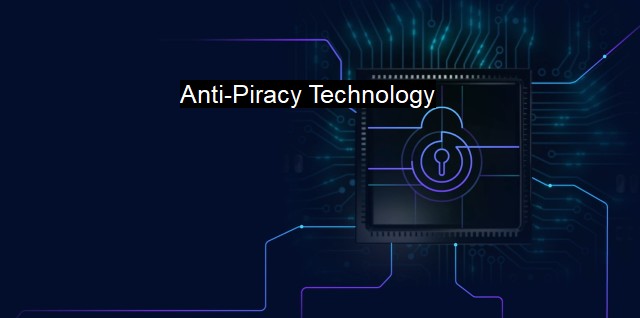What is Anti-Piracy Technology?
How Anti-Piracy Technology Safeguards Intellectual Property Rights and Counters Economic Losses: An Overview of Technical Measures and Legal Actions.
Anti-piracy technology refers to methods and tools employed mainly to prevent unauthorized reproduction or use of copyrighted material. The advent of the digital age has opened up new platforms for rapid sharing, facilitating widespread piracy, thus necessitating the intricate development of anti-piracy technology in cybersecurity and antivirus realms.Common examples of media that may fall foul to piracy include audio clips, video files, software packages, and many other digital goods. With the internet making it easier for people to share files globally, without physical delivery or transactional costs, the potential for piracy has dramatically increased, elevating it to an international issue. As such, anti-piracy technology plays a vital role within cybersecurity strategies, helping to secure digital materials and prevent unauthorised distribution or use.
Anti-piracy technology falls broadly into two categories: passive and reactive. Passive anti-piracy technology involves the implementation of measures that aim to prevent piracy from taking place initially. This includes the use of Digital Rights Management (DRM) systems, encryption, product keys, and licensing agreements. The essence is to make it more challenging to make illegitimate copies and use of copyright work.
Digital Rights Management (DRM) systems are widely used in various digital media, including eBooks, music, film and software applications. These systems use encryption and digital marking techniques to lock content down and prevent unauthorized copying or sharing. In some instances, DRM systems may require users to authenticate through an online server each time they wish to use the media, ensuring that only accredited users have access to the content.
Software programmes frequently use product keys and licensing plan agreements to prevent piracy. When a user buys a product, they are issued a unique product key required during installation. If a person attempts to share the program with others by copying the disk, the product cannot be installed without the product key. software licensing sets rules on the number of devices on which a purchased program can be installed, curbing multiple installations of a single purchase blight.
On the other hand, reactive anti-piracy measures focus on identifying and taking action against cases of piracy that have already occurred. These actions can be as simple as cease and desist letters, or as complex as international lawsuits. Anti-virus software commonly incorporates reactive anti-piracy measures. Specialised tools or facets of an anti-virus program might be designed to scan networks and isolate pirated software, subsequently removing it.
Despite advancements in anti-piracy technology and the sophistication it brings, no measure is foolproof as there is one significant drawback – the interminable struggle against piracy creators. Throughout the development of anti-piracy technology, pirates have continually overcome each security measure established, rising to overcome every obstacle thrown their way; thus, creating an ongoing war of attrition.
Anti-piracy technology represents a significant sector with developing and implementing strategies and systems to counteract digital piracy. It incorporates both preventive methods, designed to stop piracy from happening in the first place, and reactive measures that seek to identify and react to instances of piracy after they have taken place. Regardless of the never-ending descent between developers of anti-piracy technology and pirates, it's an adversarial relationship that persistently strives for equilibrium in the digital world. As future innovations in the digital age continue to accelerate, so too will the innovative solutions required to protect against digital piracy.

Anti-Piracy Technology FAQs
What is anti-piracy technology?
Anti-piracy technology refers to a set of measures that are implemented to prevent unauthorized use, replication, or distribution of copyrighted digital content such as software, music, movies, and games.What are the benefits of anti-piracy technology?
Anti-piracy technology helps to protect the intellectual property rights of content creators and copyright owners. It also helps to reduce revenue loss by preventing piracy and illegal distribution of copyrighted content. Additionally, anti-piracy technology can help to maintain the quality and integrity of digital content by preventing unauthorized modifications or alterations.How does anti-piracy technology work?
Anti-piracy technology works by incorporating various security measures such as encryption, digital watermarking, and access control mechanisms to prevent unauthorized access, copying, or distribution of copyrighted content. Some anti-piracy technologies also use advanced algorithms to detect and flag suspicious activities and potential threats.What are some common examples of anti-piracy technology?
Some common examples of anti-piracy technology include Digital Rights Management (DRM), software activation keys, CD or DVD copy protection, and online authentication systems. Anti-piracy technology can also be integrated with antivirus and firewall software to provide additional layers of protection against malware and cyber threats.| | A | | | B | | | C | | | D | | | E | | | F | | | G | | | H | | | I | | | J | | | K | | | L | | | M | |
| | N | | | O | | | P | | | Q | | | R | | | S | | | T | | | U | | | V | | | W | | | X | | | Y | | | Z | |
| | 1 | | | 2 | | | 3 | | | 4 | | | 7 | | | 8 | | |||||||